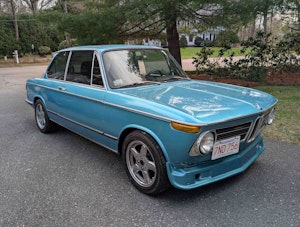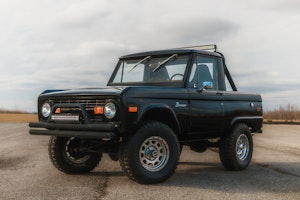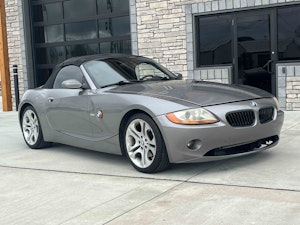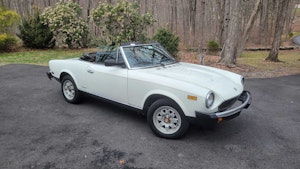Media | Articles
How Steve McQueen really created Bullitt’s famous car chase
There will be many people who have watched 10 minutes and 53 seconds of Steve McQueen’s Bullitt without knowing anything about the plot. You don’t need to, because the car chase is probably the best (only?) reason to watch the entire movie.
That could be a little unfair, but there’s no denying that the 1968 film’s iconic status is thanks to the San Francisco car chase. One YouTube video, posted eight years ago, has racked up 2.6 million views, while a shorter clip on the Movieclips channel has been watched 5.3 million times. We’re going to, ahem, bite the bullet, by naming it the best movie car chase of all time.
There’s nothing to suggest that the as yet un-named, new Frank Bullitt movie will include a chase sequence. According to Deadline, the new film, directed by Steven Spielberg and starring Bradley Cooper, is not a remake. Instead, it’s a new idea centered on the San Francisco cop, who may or may not need to chase down a couple of hitmen in a Dodge Charger.
Josh Singer (First Man, The Post, Spotlight) is writing the screenplay for the film in development at Warner Bros., which is expected to take Bullitt in a different direction to the original. In that flick, Steve McQueen played the no-nonsense cop on a mission to discover who was responsible for killing a witness in his protection.
With the Bullitt reboot in pre-production, there’s plenty of time to speculate about the details of the movie. Will it be set in San Francisco? Will it include a car chase? Could we see another role for Ford? Would a Mustang Mach-E be a suitable replacement for a Highland Green Ford Mustang GT 390?
Marketplace
Buy and sell classics with confidence

One thing’s for sure, the new movie will have a tough job delivering the gritty realism of the original. Director Peter Yates, who was selected by Steve McQueen following his work on the 1967 film Robbery, delivered a film with a high level of authenticity.
Car enthusiasts will remember the streets of San Francisco as the setting for the car chase, but the film is also notable for being shot almost entirely on location. Real doctors and nurses were used for scenes at San Francisco General Hospital, while the office of an actual architectural practice was used for scenes involving Frank Bullitt’s girlfriend Cathy (Jacqueline Bisset).
With this level of attention to detail, is it any wonder that the car chase looked so authentic? The scenes involving the Ford Mustang and Dodge Charger looked real because it was real.
Well, up to a point.

In a 2018 interview with Classic & Sports Car, Yates said: “[The film] came about because Phil D’Antoni, who was producing the film, had seen the chase in my movie Robbery. He knew of McQueen’s love of fast driving, but I was a bit concerned because I’d already done a chase and didn’t want to do another one. The fact that Robbery had been seen by so few people in America hardly entered my head.”
Without McQueen’s influence, there’s a strong chance that the film would have made it into production without its most famous scene. Yates claims that it wasn’t in the original script; Mute Witness, the book upon which the film is based, doesn’t feature a car chase. In interviews, McQueen insisted that it was his idea, with the 15-minute opening car chase in Robbery enough to convince writer Alan Trustman to change the script.
In a 1969 Motor Trend interview, McQueen said: “I always felt that a motor-racing sequence in the street could be very exciting because you have real objects to work with, like bouncing off a parked car. An audience digs sitting there watching somebody do something I’m sure almost all of them would like to do.” Legend has it that some moviegoers were sick during the famous chase sequence.

To perfect the car chase, McQueen drafted in four of his mates: stuntmen Max Balchowsky, Bud Ekins, Bill Hickman and Carey Loftin. Hickman is the bespectacled driver of the Dodge Charger, who also worked with D’Antoni on The French Connection and The Seven-Ups, two films known for their car chase scenes.
In a 1968 film promo, McQueen said: “From the beginning, we felt that we should start off working in close harmony at a racetrack so that Bill Hickman and myself would be used to working closely together at high speed.” The pair spent a couple of weeks at the old Cotati Speedway, 45 miles north of San Francisco, where they reached speeds “well over the ton [100 mph] mark.”
A promotional agreement between Ford and Warner Bros. dictated that Frank Bullitt would drive a Mustang, with the hitmen in a Galaxie. Unfortunately, the Galaxies were too slow for the jumps, so three Dodge Charger R/T 440s were sourced from a Chrysler dealer in Glendale.


Loren Janes, who starred as a double for Steve McQueen, said: “Many writers have said two, but there were three of each. We needed the extra cars in case one was damaged. The movie’s shooting schedule can’t be slowed for dents and things like that. Fortunately, we only had to use a second Mustang once when the first Mustang had to go in to be fixed up.”
This appears to have been debunked by Sean Kiernan, the former owner of the Mustang driven by McQueen in the movie. In an interview with Octane, he said: “Chassis #559 was ‘refreshed’ after filming and used for the promotional tour, and many thought it was a third identical car.”

Chassis 558 was discovered in spring 2017 in a Mexico scrapyard, while 559, arguably the most famous Mustang in the world, sold for $3.74M in 2020.
The cars used in the movie were sent to Max Balchowsky’s workshop to be toughened up for filming. Modifications included heavy duty springs and dampers plus strengthened pick-up points. Although the Charger looked stock, McQueen insisted on making changes to the Mustang, which extended to the removal of some trim, a coat of black paint for the grille, and a set of American Racing Torq-Thrust wheels. McQueen also drafted in his friend Tony Nancy to retrim a Shelby GT500 (Secura) steering wheel in leather.
Filming took place over two weeks using up to 30 square blocks of San Francisco, 50 people armed with walkie-talkies, and eight stuntmen in other cars. McQueen said, “When we were going by [the stuntmen] at well over 100 mph, we knew what they were gonna do and they knew what we were gonna do.”
The result is nearly 11 minutes of near perfection. In the same way that Mark Kermode says you can forgive an actor’s terrible attempt at an accent, if you’ve bought into Bullitt‘s cast and dialogue, you’re able to gloss over the glaring continuity errors. The Charger’s eight flying hubcaps, the 16-speed Mustang, and the multiple sightings of the green VW Beetle and white Pontiac Lemans—both used as “control cars”in the downhill road scenes—can be overlooked because the action is so tense.
From the moment Bill Hickman buckles up, and Lalo Schifrin’s brooding score gives way to the sound of engines, tyre smoke and fender benders, you’re gripped by the realism of Mustang versus Charger and McQueen versus Hickman.
Peter Yates told Classic & Sports Car: “I accompanied [McQueen] in the Mustang on one of the hill-jumping sequences to keep an eye on him. After one of the jumps, I had to tell him to slow down because we were running out of film.
“‘That’s nothing,’ Steve replied. ‘We’re out of brakes.’
“McQueen managed to slow the Mustang by slotting down through the gears and turning the car onto a street that inclined upwards. When the car came to a stop, we roared with nervous laughter.”
Contrary to popular belief, McQueen didn’t do all of the driving. In the same way that McQueen had to leave the famous motorcycle jump in The Great Escape to his friend Bud Ekins, insurance restrictions prevented the King of Cool from doing the most dangerous scenes.
Talking about driving down Chestnut Street, Ekins said: “It was like looking down a ski jump. At 60 mph, it felt as if I was driving off the end of the world.”
Ekins also stars as the motorcycle rider who is forced to take evasive action prior to the chase sequence’s explosive conclusion.
As an aside, the driver of the Mustang when the Charger is sent careering into the petrol station is Carey Loftin, who starred as the truck driver in the 1971 thriller Duel, Steven Spielberg’s first feature-length film. We’ve almost gone full circle.
To paraphrase a line from a song by Lee Majors: Ekins and Loftin were the unknown stuntmen who made McQueen such a star, two unsung heroes of the best car chase scene in Hollywood history.
Steve McQueen wanted to make sure that he got the glory for the chase. Notice how he sticks his head out of the window when reversing, having overshot a corner in pursuit of the Charger. It’s a mistake that made the final cut, with Yates saying: “Steve wanted audiences to know exactly who was driving the car.”
Five decades on, it’s Bradley Cooper’s turn to play the role of Frank Bullitt, and although the inclusion of a car chase isn’t guaranteed, we suspect the new film will have fewer flying hubcaps and a greater reliance on CGI. In the meantime, car enthusiasts will continue to marvel at what McQueen achieved with more than a little help from his friends.
Check out the Hagerty Media homepage so you don’t miss a single story, or better yet, bookmark it.





















They should make sure it has a Green VW Bug .
Those who don’t think it’s the best chase scene ever filmed haven’t seen it on a theater screen. I was 17 and looking for my seatbelt!
How did that green VW Bug keep showing up? If I’m not mistaken, both cars passed it a couple of times.
The new Bullitt movie will certainly be much better than the original with Steve McQueen. So as not to offend the environmental community the chase scene include specially outfitted EVs, not those evil gas powered vehicles. Yes, it will include a modified Mustang EV SUV vs a new Dodge Charger EV. Uh, oh, there’s a problem: half way through the chase scene they’ll have to take a time-out to recharge the batteries because all those speeding scenes have quickly drained the batteries. But don’t worry because the chase scenes will conveniently take place near well-placed charging stations. And while the cars are charging, electric bikes will be provided to the cop and the bad guys so that they can continue their chase scene, albeit at a bit slower pace. But you can rest assure that the movie producers will encourage the use of good, clean, environmentally friendly energy. And you don’t have to worry about the noise pollution created by revving engines since the EVs are quiet Instead of the sounds of those offensive revving internal combustion engines, the director and producer will play some soothing Henry Mancini background music during the chase. Welcome to the wonderful world of the 21st century.:)
Does nobody notice the final chase scene mistake when the Charger passes right past the fuel tanks it allegedly crashes into and explodes? Watch it again.
“To live and die in LA” has a great car chase!
Why did they build the Mustang with an open differential rather than a Detroit Locker so that Steve M could put down two black stripes on the pavement?
My dad took me to see it at a drive- in. Watching the chase scene while actually sitting in a car was well worth the $2 admission. The car was a 1965 Mercedes diesel, so there were no jumps or slides on the way home, but I’ll never forget that chase, even sitting in the passenger seat. Dad stepped on the brake a few times until the guy behind us flashed his lights and honked his horn. It was a double feature with Bonnie and Clyde, which was pretty good too. I was 13 years old. I miss my dad every day.
The car and McQueen were the perfect pairing….like the Lone Ranger and Silver. I was 20 when the movie came out, and was driving a 289 high performance GT fastback mustang, burgundy, white rally stripes low on the sides; had a cobra exhaust system on it that sounded just like Bullitt’s car and a stock rally pack on the steering column that made the drivers seat badass AND it would fly….never lost to any other mustang or any 327 Camaro. Kept the car until 1973 when I sold it for $650 I think of how it felt with the iconic McQueen as an inspiration in a lot of my drives. I wonder frequently what became of that car and to this day lament parting with it. I saw one identical to mine go on Barrett-Jackson a couple years ago for $235K. Can’t wait for the new movie!
I would like to challenge Spielberg to not use CGI and do it all real time.
Great subject , great article, great times….
With all the digital and technological innovations since Bullitt was released, it should be possible to dis the phantom Bug and keep the hubcaps on the Charger until it’s final flame out. Imagine !
As many times as I have watched the chase scene I must have been so engrossed in it that I only remember the Charger losing 5 hubcaps. One of the things that it so engrossing is all of the action is possible, not like modern computer generated scenes that everybody knows are impossible in real life.
I saw the Movie 9 times I never get tired of it.
In reality, no way could 390 Mustang keep up with 440 Charger.
Maybe in a drag race, but in the scenario depicted in the movie, a 390 Mustang could definitely keep up with a 440 equiped Charger.